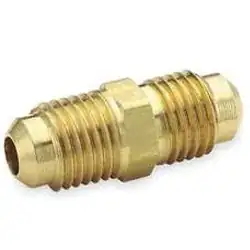I had to replace the transmission in my 93 Dakota. To get it to drop I had to cut the metal coolant lines that lead to/from the radiator. The stock lines are .315 ID. My question is, can I use a rubber hose instead? I know they make ATF strength hoses. I've even heard that upping the size to .5 ID would actually help.
2 Answers
The best way to fix this is to use flared butt ended fittings, or to replace the line whole. The rubber, while it will hold, is still the weak link in the chain. Over time it will weaken and wear, and ultimately fail. Using the dual ended but joint like I have pictured below (or something like this), if installed correctly, will not fail any sooner than the metal line itself will. On the ends of this will be brass nuts which will slip over the line, then you'll need to flare the ends. This is called a Brass Flare Fitting. They make all different sizes, but you'll need it to be a butt connector type to work properly and have the least amount of resistance to transmission fluid flow.
- 165,084
- 32
- 259
- 508
You can use proper hose without a problem. Just make sure it's SAE J1532 or J1019 hose - it should be stenciled on the sides - most auto parts stores sell this "transmission cooler line hose" by the foot. You'll likely need 3/8 or .325 ID.
Make sure there's 2-3 inches of overlap on each end of the cut metal. Double clamp each end with quality clamps spaced about a half inch apart.
This, done properly, will not "blow tranny fluid all over the road". It's far more likely the original pipes will rust out, and THAT will be the weak link fail. In fact, Dorman makes replacements because this is a very common problem on that age of Dakotas. And the parts are cheap, too - probably less than $75 for the pair. Installation is not a breeze, however. But it avoids the rust problem that might be headed your way as well.
While I agree a perfectly proper job should be complete replacement, the cost-effective and "just fine" approach for that age of vehicle suggests patching using quality rated hose and clamps. Note that the OEM arrangement has a rubber section (with crimps that often fail), since hard-mounted lines between the moving elastomer-mounted transmission to the chassis-fixed radiator would fatigue and fail metal lines in no time.
- 12,432
- 2
- 26
- 47
